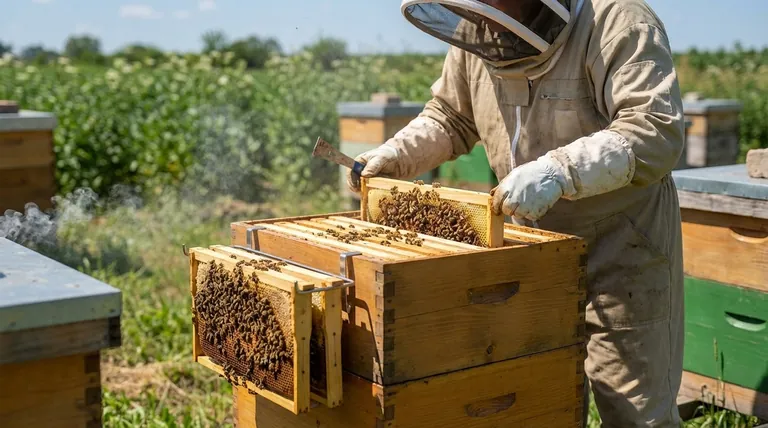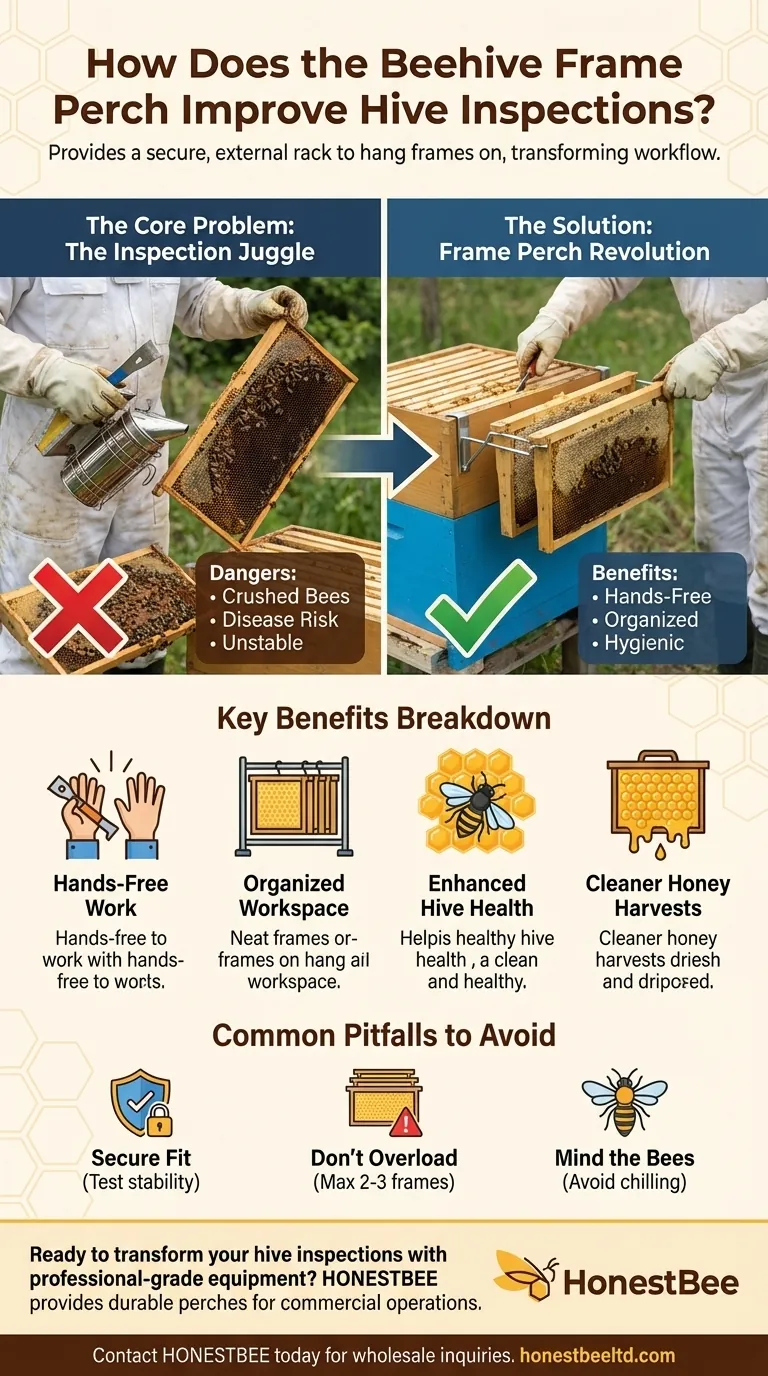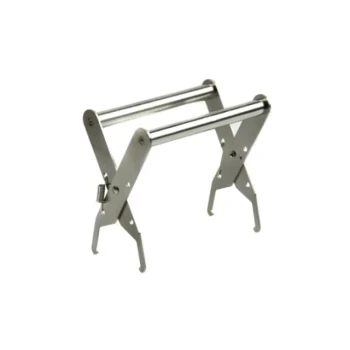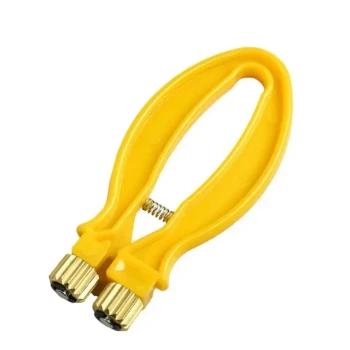At its core, a beehive frame perch, or frame rest, improves hive inspections by providing a secure, external rack to hang frames on. This simple tool fundamentally changes your workflow, freeing up your hands and creating an organized space, which prevents you from having to place delicate frames on the ground or precariously lean them against the hive.
The true value of a frame perch isn't just convenience; it's about transforming a potentially clumsy and risky process into a controlled, efficient, and hygienic operation that protects your bees and your back.

The Core Problem: The Inspection Juggle
Anyone who has performed a hive inspection understands the challenge. You need to remove a frame to create working space, but your hands are already full with a hive tool and smoker, leaving you with a difficult choice.
The Need for a Third Hand
A single frame can be heavy with honey and covered in thousands of bees. Holding it steady with one hand while trying to use a tool, brush bees away, or take a photo with the other is difficult and increases the risk of dropping the frame.
The Dangers of Makeshift Solutions
The most common "solutions" without a perch are hazardous. Placing a frame on the ground can kill the queen if she is on it, crush other bees, and pick up dirt, pesticides, or diseases like foulbrood spores. Leaning it against the hive is unstable and can lead to the frame falling over.
How a Frame Perch Revolutionizes Your Workflow
A frame perch is a simple metal bracket that hangs securely on the side of the hive body. By solving the "what do I do with this frame?" problem, it provides a cascade of benefits.
It Creates an Organized Workspace
A perch allows you to remove the first one or two frames and hang them outside the box. This creates ample working space inside the hive, allowing you to slide subsequent frames easily instead of prying them out. You can keep the frames in order, which is critical for returning the brood nest to its original configuration.
It Frees Both Your Hands
With frames safely hung on the perch, you now have two hands free. This is a game-changer. You can properly manipulate other frames, use your hive tool effectively, mark a queen, take clear notes, or assess brood patterns without feeling rushed or clumsy.
It Protects Your Bees and Hive Health
Hanging frames on a perch is the best way to ensure they remain clean and safe. It prevents you from accidentally crushing bees between the frame and the ground. Most importantly, it is a key biosecurity practice, minimizing the risk of contaminating your frames and introducing disease into the colony.
It Keeps Honey Frames Clean
During a harvest, a perch is invaluable for holding frames full of capped honey. It keeps them pristine and free from grass, dirt, or ants before you move them indoors for extraction.
Common Pitfalls to Avoid
While a simple tool, a frame perch is most effective when used correctly. A few considerations ensure you get the most out of it.
Ensure a Secure Fit
The perch should hook firmly onto the wall of your hive box. A loose or wobbly fit can be unstable, so always test that it is secure before hanging a heavy frame of honey on it.
Don't Overload the Perch
Most frame rests are designed to hold two or three frames. Attempting to hang more can strain the perch and the hive box, creating an unnecessary risk. It is a temporary workspace, not a storage unit.
Remember Your Bees
Be mindful of the bees on the frames you hang on the perch. On a cool or windy day, leaving a frame of open brood outside the hive for too long can chill the larvae. Work efficiently and return the frames to the warmth of the cluster in a timely manner.
Making the Right Choice for Your Goal
A frame perch is a small investment that pays significant dividends in efficiency and hive health.
- If your primary focus is efficiency: A perch is essential for creating a smooth, repeatable inspection process that saves you time and frustration.
- If your primary focus is hive health and biosecurity: It is a non-negotiable tool for preventing contamination and protecting your bees from injury and disease.
- If you are a new beekeeper: A perch dramatically simplifies the complex task of an inspection, helping you build confidence and establish good habits from the start.
Ultimately, integrating a frame perch into your routine empowers you to become a more methodical and gentle beekeeper.
Summary Table:
| Benefit | Description |
|---|---|
| Hands-Free Work | Securely hangs frames, freeing both hands for tools and tasks. |
| Organized Workspace | Creates space in the hive and keeps frames in order for easy reassembly. |
| Enhanced Hive Health | Prevents frame contamination and protects bees from being crushed. |
| Cleaner Honey Harvests | Keeps honey frames pristine and free from dirt and pests during extraction. |
Ready to transform your hive inspections with professional-grade equipment?
As a trusted supplier to commercial apiaries and distributors, HONESTBEE provides durable, well-designed beehive frame perches that integrate seamlessly into your operation. Our wholesale-focused model ensures you get the reliable tools you need to improve efficiency, maintain superior hive health, and protect your valuable investment.
Contact HONESTBEE today to discuss your equipment needs and learn more about our full range of beekeeping supplies.
Visual Guide

Related Products
- Heavy-Duty Stainless Steel Clip-On Frame Perch
- Heavy-Duty Stainless Steel Frame Perch
- Heavy-Duty T-Style Frame Perch
- Plastic Bee Frame Beekeeping Hive Frames for Wholesale
- Assembled Wooden Bee Frames with Beeswax Foundation Ready to Use by HONESTBEE
People Also Ask
- How many frames can the beehive frame perch hold? Organize Your Hive Inspections with Ease
- What are the advantages of using a frame rest for the bees? Achieve Calmer, Safer Hive Inspections
- How many frames can a frame perch hold? Optimize Your Hive Inspections with the Right Tool
- What is the purpose of the frame perch? A Game-Changer for Efficient Hive Inspections
- How does the frame perch ensure stability during use? Secure Your Hive Inspections with Physics-Driven Design



















